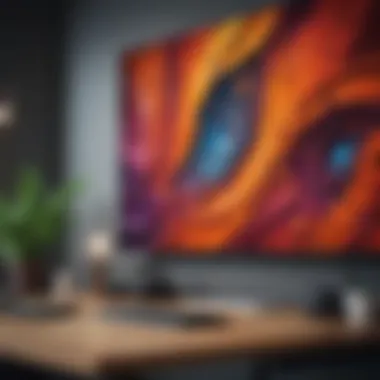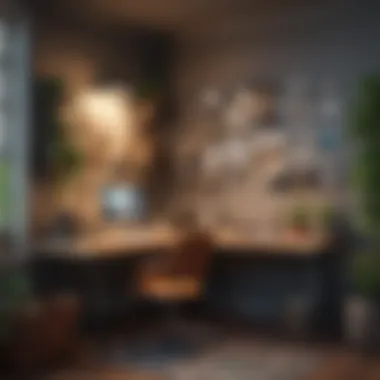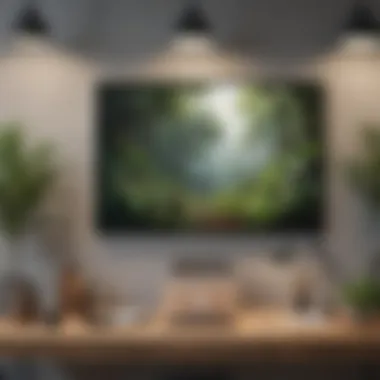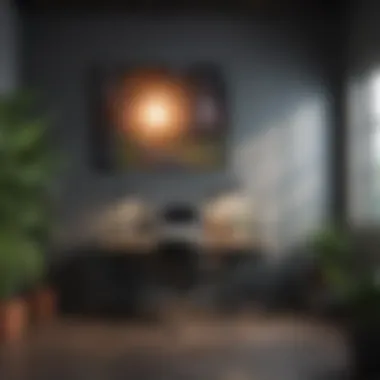Exploring Office Wall Art for Creative Workspaces


Intro
Creating an inspiring workspace has becoming increasingly important, especially as remote work gains popularity. Wall art plays a significant role in this transformation. It has the power to reflect personal style, foster creativity, and enhance productivity. In this article, we will explore the diverse aspects of office wall art, examining how it can elevate the standard office environment into a vibrant and motivational area.
The selection of art can impact everything from employee morale to the overall atmosphere. Different styles and placements can cater to varied office aesthetics. By understanding the significance of this topic, readers will gain valuable insights and practical strategies to enrich their workspaces with creative choices. Let's begin by looking into some design inspiration.
Understanding the Role of Wall Art in Offices
Wall art serves as more than mere decoration in an office environment. It plays a pivotal role in shaping the ambiance and mood of the workspace. The presence of thoughtfully selected art can greatly influence overall employee satisfaction and engagement. Certain types of art can inspire creativity, evoke feelings of tranquility, or even stimulate conversations among coworkers.
Art can enhance the aesthetic appeal of dull and sterile office settings, transforming them into visually stimulating spaces. An effective art selection process takes various factors into account, including the company culture, brand identity, and the personal tastes of employees. This process can foster a sense of belonging and ownership, making individuals feel more connected to their workplace.
Psychological Impact of Art
The psychological effects of art in work settings are significant. Art has been shown to have a profound impact on mental well-being. For instance, incorporating vibrant colors can create a sense of energy and positivity, while softer tones may promote calmness. Exposure to art can also lead to increased feelings of happiness and reduced stress levels.
Research suggests that individuals who work in environments adorned with artwork might experience less anxiety and a greater inclination towards collaboration. This aspect is critical, as a cooperative atmosphere can enhance team dynamics.
In practical terms, choosing art that reflects the mood and values of the organization can reinforce a sense of identity among employees. Visually compelling pieces can serve as reminders of the company's mission and goals, allowing workers to align their daily tasks with broader objectives.
Influence on Productivity and Creativity
Art's influence on productivity and creativity cannot be overlooked. Studies indicate that a well-decorated workspace can enhance focus and efficiency. Employees exposed to art tend to report higher satisfaction levels and a boost in motivation. This is important for any modern workplace aiming for innovation and productivity.
Furthermore, creativity thrives in environments that encourage new ideas and perspectives. Introducing different art forms can stimulate creative thinking and inspire collaborative discussions among team members. When employees feel free to express themselves through their surroundings, they are more likely to contribute unique ideas.
In summary, understanding the role of wall art in offices is essential for enhancing workplace dynamics. Both the psychological and productivity benefits demonstrate that art is not just an accessory but a vital component to consider in office design. By making informed choices about art, employers can create a more productive, happier, and healthier work environment.
Art is not only an image on the wall; it’s a catalyst for meaningful engagement and productivity.
Types of Office Wall Art
The distinction between various types of office wall art is essential for creating a workspace that resonates with both the aesthetics and values of the organization. Each type of wall art serves a unique purpose and can contribute significantly to the overall atmosphere of the office. Understanding these categories allows individuals and decision-makers to select the appropriate art forms that align with their brand identity and create a motivating environment for employees.
Framed Art and Prints
Framed art and prints remain timeless choices for office decor. They can feature anything from classic paintings to modern graphics, making them versatile for various interior styles. The main advantage of this type of art is its ability to elevate the office's ambiance without overwhelming the space.
Choosing framed art also allows for easy change, reflecting the changing seasons or themes of the workplace. Artworks can be easily switched out to maintain a fresh environment, enhancing employees’ creativity and engagement. When selecting prints, consider the message and emotion conveyed. Choosing artwork that aligns with company values can reinforce the organizational culture.
Canvas Art
Canvas art is often more textured and voluminous compared to prints. This type of wall art brings a modern flair to the office, with many options ranging from abstract to realistic representations. What sets canvas art apart is its material; the depth of the canvas creates a three-dimensional effect, adding to the visual interest.
Beyond aesthetics, canvas art is renowned for its durability. Unlike paper prints, canvases resist fading over time, maintaining their vibrancy. This makes them a smart long-term investment for any office looking to create a lasting impression. Moreover, they can also be personalized easily, catering to unique tastes and styles of specific teams or departments.
Murals and Wall Decals
Murals and wall decals can transform an ordinary office into a visually captivating space. They can cover entire walls, making a bold statement and creating a strong focal point. Murals are ideal for collaborative spaces, cold areas like lobbies, or areas in need of revitalization. A well-designed mural can inspire employees and visitors alike, fostering a creative atmosphere.
Wall decals, on the other hand, offer flexibility. They provide the opportunity to add quotes, symbols, or graphic designs without a permanent commitment. They are easy to apply and remove, allowing for seasonal updates or office redesigns. Furthermore, both murals and decals can reinforce a brand's message effectively through visual storytelling.


Photographs and Personal Artifacts
Photographs and personal artifacts provide a unique touch to office walls. These can be images that depict the company's history, important milestones, or even employee achievements. Having such artifacts adds a personal touch, reminding everyone of their shared journey and accomplishments.
Moreover, showcasing local culture or team pictures can help in creating a sense of belonging and community among employees. Such art fosters emotional connections and can motivate staff, ultimately enhancing productivity. When selecting photographs, it is essential to reflect authenticity and consideration of the audience within the workplace.
Choosing the Right Art for Your Office
Choosing the right art for your office is a task that holds significant implications for both the aesthetic appeal and functionality of your work environment. The art you select should resonate with the overall vibe of your workspace and the people who occupy it. Good art not only beautifies the walls; it can also elevate mood, stimulate productivity, and even communicate your organizational culture. Thus, understanding how to choose art that aligns with your office goals is essential.
Assessing Your Office Style
Before diving into art selection, one must evaluate the existing style of the office. Every workspace has a unique character, influenced by design elements such ascolor scheme, furniture, and layout. Is your office modern and sleek, or does it have a more traditional, rustic feel? Identifying this will guide your choices.
- In a contemporary setting, abstract art or minimalistic prints may fit seamlessly.
- Conversely, a classic office might benefit from timeless classics such as landscape paintings or historical photographs.
- Consider textures in addition to colors. A textured piece may add depth to a minimalist decor by introducing a focal point without overwhelming the space.
Color Psychology in Art Selection
Colors carry psychological weight. They can affect emotions, energy levels, and productivity. When choosing art, it is wise to consider how colors might influence the office atmosphere.
- Calming hues like blues and greens promote relaxation and focus, ideal for workstations or meeting rooms.
- Warm colors like reds and oranges can energize a space but should be used carefully as they can create a sense of chaos if overdone.
- Staying within your existing color palette can maintain harmony. Try to complement or contrast art with the primary colors already present to avoid clashes or confusion in visual appeal.
Art that Reflects Company Values
Art can serve as a visual representation of your company’s core values. Choosing pieces that evoke your brand identity can reinforce your mission and vision internally and externally.
- If sustainability is a priority, consider artworks made from eco-friendly materials. This not only speaks to your values but also promotes awareness among employees and clients.
- Local art can show your commitment to community engagement, making it a meaningful addition to the office.
- Display pieces that resonate with teamwork, innovation, or creativity to foster an environment that embodies those characteristics.
"Art in the workplace can significantly contribute to a positive employees experience. It reflects an organization’s identity and enhances overall experience."
In summary, selecting the right art for your office involves a thoughtful evaluation of your space, color considerations, and alignment with company values. The right artworks can transform ordinary walls into vibrant expressions of creativity and purpose.
Placement and Display Techniques
Placement and display techniques for office wall art are crucial in maximizing their impact on workspace. The arrangement of art can influence the overall aesthetic and emotional environment within an office. Thoughtfully chosen locations and specific display methods enhance visual interest while promoting creativity and productivity among employees.
Height and Orientation Considerations
Height matters when hanging wall art. It is typically recommended to position art at eye level. This not only makes the piece easily noticeable but also creates a sense of accessibility. An ideal height is around 57 to 60 inches from the floor to the center of the artwork. This standard allows most people to appreciate the art without straining their necks.
Orientation is also significant. For example, vertical art can draw the eye upward, making a room feel taller, while horizontal pieces can visually widen the space. This can be strategically employed to create an atmosphere that suits the office's ethos, whether it is formal or more relaxed.
Creating Visual Harmony
Creating visual harmony involves selecting art that complements existing office decor. This includes considering color schemes, patterns, and styles already present in the workplace. An effective approach is to keep a cohesive palette. For instance, choosing art pieces that reflect the primary colors of the office can unify the space.
Another element to consider is the proportion of the wall art to the wall on which it will be displayed. Large walls may benefit from oversized pieces or a gallery arrangement, while smaller areas might call for a single, striking piece. The arrangement should aim at balance, avoiding cluttered looks that can detract from the overall sense of harmony.
Mixing Different Art Styles
Mixing different styles can breathe life into an office. However, it should be done with care. A chaotic assortment can create distraction rather than inspiration. Instead, find ways to blend various art forms, like contemporary prints alongside classic paintings. This can create a dynamic visual narrative while maintaining a cohesive theme.
When mixing styles, consistency in frame types or sizes can help to create a uniform look. For example, using similar frames in different colors can harmonize diverse pieces.


"Art should be a reflection of creativity in the workplace, promoting a stimulating environment."
In summary, the placement and display techniques of wall art within offices play a significant role in shaping the workspace ambiance. Attention to height, orientation, visual harmony, and the thoughtful mixing of styles ensures that office wall art not only beautifies but also enhances the work environment.
Budget-Friendly Art Options
Creating an inspiring workspace does not have to depend on a large budget. Budget-friendly art options allow both employers and employees to transform offices without spending excessively. These alternatives provide distinct benefits. They contribute to a personalized environment while enhancing creativity and productivity.
Incorporating budget-friendly art options shows a commitment to fostering an engaging workspace. By paying attention to the art selection, organizations can improve employee morale and satisfaction. Unique pieces of art can spark conversations, making the workplace more enjoyable.
Exploring Local Artists and Artisans
Local artists often provide unique pieces that reflect the culture and spirit of the community. Engaging with them not only supports the local economy but brings original artwork to the office. To find local artists, attend art fairs, gallery openings, or community events.
- Collaborate with Local Art Schools: Reach out to local art schools or universities. Students often seek exposure and experience. This collaboration can yield diverse artwork at affordable prices.
- Visit Art Galleries: Explore nearby galleries displaying local artists’ work. Many sell pieces at reasonable prices compared to well-known art dealers.
Supporting local talent fosters a sense of belonging and connection within the office. Art created by local artists tells a story and creates a connection to the area.
Online Marketplaces for Unique Finds
The internet is a treasure trove for affordable art options. Websites like Etsy, Redbubble, and society6 host numerous artists offering their work at varying price points. Here are some tips to use online marketplaces effectively:
- Search for Emerging Artists: Many new artists sell their work at competitive prices to build portfolios.
- Use Filters Effectively: Leverage filters to narrow results based on price range, style, and size.
Additionally, online platforms often have sales or discounts. Therefore, subscribing to newsletters can lead to great deals on unique finds. Shopping online also opens access to art from around the world, broadening the range of options.
Repurposing and Upcycling Existing Pieces
Repurposing and upcycling existing art can infuse freshness into any workspace without incurring additional costs. This process involves taking old pieces and transforming them into something new and appealing.
- Reframe Old Artwork: Changing the frame can rejuvenate a tired piece of art. Select modern or colorful frames to update the look.
- Combine Smaller Pieces: Create a gallery wall by grouping smaller works together. This approach personalizes the space and adds depth.
- DIY Changes: Consider making art projects from materials around the office. Items like old magazines, fabric scraps, and colored paper can become unique artworks.
"Upcycling not only saves money but also promotes sustainability."
Repurposing art encourages creativity, reduces waste, and creates a unique work environment. It highlights the individuality of office space while keeping costs low.
DIY Wall Art Projects
Creating your own wall art can significantly enhance your workspace. This section explores why DIY wall art is an essential aspect of office decor and how it can be beneficial for personal expression and overall environment.
One primary advantage of DIY projects is personalization. When you create art that reflects your own taste and interests, it gives a unique character to your workspace. This can make the environment feel more welcoming. It also encourages creativity, helping to inspire new ideas.
Another benefit is cost-effectiveness. Stores often charge high prices for art; however, using materials at hand or inexpensive supplies can yield stunning results. Moreover, DIY projects can foster teamwork among employees. Collaborative art creation can bring people together, strengthening workplace relationships.
Simple Painting Techniques
Simple painting techniques serve as a gateway for many to delve into the world of DIY wall art. It does not require extensive skills. You can begin with basic acrylic painting. Consider using stencils or tape to create shapes and patterns.
The use of bold colors can energize the workspace. Light and pastel shades can promote a sense of calm. All this depends on the mood you wish to foster. Experimenting with techniques like ombre or splatter painting can also add vibrancy to the wall. Here are some elements to consider when painting:
- Choose a color scheme that aligns with your office aesthetic.
- Use high-quality materials for durability.
- Prepare your surface correctly to ensure paint adherence.


Collage and Mixed Media Art
Collage and mixed media art offer another avenue for creativity. Using various materials can produce unique pieces that catch attention. This form of art allows integration of personal photographs, fabric remnants, or even recycled items.
To begin, gather materials that speak to you. Cut out images from magazines or print meaningful quotes. Arrange these items on a canvas or heavy paper. Mix in different textures like fabric or paper to add depth. The beauty of this approach is that it is highly customizable. You can easily change and adapt your work as your style evolves.
Creating a Gallery Wall
A gallery wall can be an excellent way to showcase multiple pieces of art. It allows you to display a collection of DIY projects or curated prints. When planning a gallery wall, consider layout and spacing carefully. Here are some steps:
- Select a focal point: This could be a larger piece that draws the eye.
- Choose a theme or color scheme: This helps in creating a cohesive look.
- Mix frames and styles: Using different frames can add interest but should still have some harmony.
- Experiment with placement: Lay the pieces out on the floor first to visualize the arrangement before hanging.
- Hang at eye level: This ensures the art is appreciated fully from a standing or sitting position.
"Creating a gallery wall can reflect your personality while showcasing your artistic choices."
In summary, engaging in DIY wall art projects not only personalizes your workspace but also enhances creativity. These projects vary from simple painting to collages and gallery walls. Each method provides a chance to express individuality through art. Engaging employees in these activities can also strengthen the workplace community.
Maintaining a Creative Workspace
Maintaining a creative workspace is key for enhancing productivity and fostering innovation. Art plays a significant role in this dynamic. An engaging environment stimulates the mind. It can improve both mood and creativity. Therefore, it is essential to keep the workspace fresh and inspiring. Regular changes to artwork can rejuvenate the atmosphere. Moreover, updating art often encourages a sense of freshness. This ensures that the employees feel connected to their surroundings.
Regular Updates to Artwork
Regularly updating the artwork in an office can have numerous benefits. First, it helps to avoid monotony. Employees can become disengaged when they see the same images for an extended period. By changing art displays regularly, companies can maintain interest and enthusiasm in the workplace. This can be achieved through various means:
- Seasonal Changes: Rotating pieces based on seasons can create a more lively and relevant atmosphere. For instance, brighter colors during spring can evoke feelings of renewal.
- Highlighting Themes: Different themes can be showcased throughout the year. This approach keeps the art relevant to ongoing company projects or cultural events.
- Employee Engagement: Involving employees in selecting new artworks can lead to a stronger connection to the workspace. It makes them feel valued and creates a shared sense of ownership.
"Art is not what you see, but what you make others see." - Edgar Degas
Updating artwork is not just about aesthetics; it can significantly influence employees’ overall job satisfaction. When the environment aligns with their values and preferences, workers feel more engaged.
Incorporating Feedback from Employees
Incorporating feedback from employees about wall art is vital for creating a harmonious workspace. Understanding their preferences fosters an inclusive environment where everyone feels appreciated. Here are some strategies:
- Conduct Surveys: Gathering opinions through surveys can help assess what types of art resonate with the team.
- Create Suggestion Boards: A physical or digital board where employees can share their ideas can encourage participation and engagement.
- Collaborate with Local Artists: Many local artists may offer pieces that reflect the company’s culture or the employees' interests. This not only supports local talent but also personalizes the workspace.
Listening to employees and valuing their input can boost morale and strengthen teamwork. The office becomes a reflection of the collective spirit, making it a more enjoyable place to work. Engaging with the staff in the decision-making process fosters a sense of belonging. It contributes to the broader goal of maintaining a creative workspace.
The Future of Office Wall Art
The future of office wall art presents a unique intersection of creativity, technology, and sustainability. As workplaces evolve to accommodate remote work and flexible arrangements, the role of art within these environments becomes even more significant. The right wall art can not only enhance aesthetics but also foster an atmosphere conducive to productivity and employee satisfaction.
Trends in Digital Art Displays
Digital art displays are setting new standards in modern office decor. These interactive screens allow businesses to showcase dynamic content, including rotating galleries of artwork, information about company values, or even messages of encouragement.
Employers can easily tailor the visuals to reflect seasonal themes or company events. Digital displays also make it easier to rotate artwork, keeping the environment fresh and engaging. This adaptability is crucial in a fast-paced work environment, where motivation can often wane.
Another trend is the use of augmented reality. This technology allows employees to interact with art pieces in a new way. They can use their smartphones to view additional layers or learn about the artist behind a particular piece. Such immersive experiences can create a profound connection between employees and their workplace.
Integrating Sustainable Art Practices
As environmental concerns grow, companies are increasingly prioritizing sustainability in various practices, including their choice of art. Integrating sustainable art practices is not just a trend but a necessary responsibility to foster a greener workplace.
This can involve sourcing artwork from local artists who use eco-friendly materials. Art made from recycled goods or biodegradable products resonates well with a socially conscious workforce.
Moreover, businesses might engage in collaborations with art programs that promote sustainability, thus providing artists and artisans a platform to display their works while supporting greener initiatives.
Organizations that incorporate sustainability into their art choices not only improve their image but also contribute positively to the environment.



